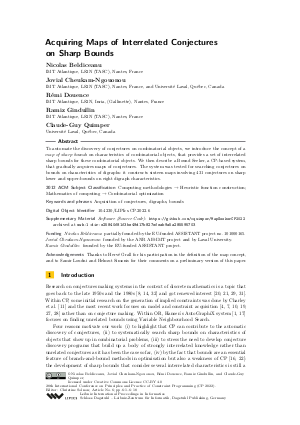@InProceedings{beldiceanu_et_al:LIPIcs.CP.2022.6,
author = {Beldiceanu, Nicolas and Cheukam-Ngouonou, Jovial and Douence, R\'{e}mi and Gindullin, Ramiz and Quimper, Claude-Guy},
title = {{Acquiring Maps of Interrelated Conjectures on Sharp Bounds}},
booktitle = {28th International Conference on Principles and Practice of Constraint Programming (CP 2022)},
pages = {6:1--6:18},
series = {Leibniz International Proceedings in Informatics (LIPIcs)},
ISBN = {978-3-95977-240-2},
ISSN = {1868-8969},
year = {2022},
volume = {235},
editor = {Solnon, Christine},
publisher = {Schloss Dagstuhl -- Leibniz-Zentrum f{\"u}r Informatik},
address = {Dagstuhl, Germany},
URL = {https://drops.dagstuhl.de/entities/document/10.4230/LIPIcs.CP.2022.6},
URN = {urn:nbn:de:0030-drops-166353},
doi = {10.4230/LIPIcs.CP.2022.6},
annote = {Keywords: Acquisition of conjectures, digraphs, bounds}
}

 Creative Commons Attribution 4.0 International license
Creative Commons Attribution 4.0 International license








